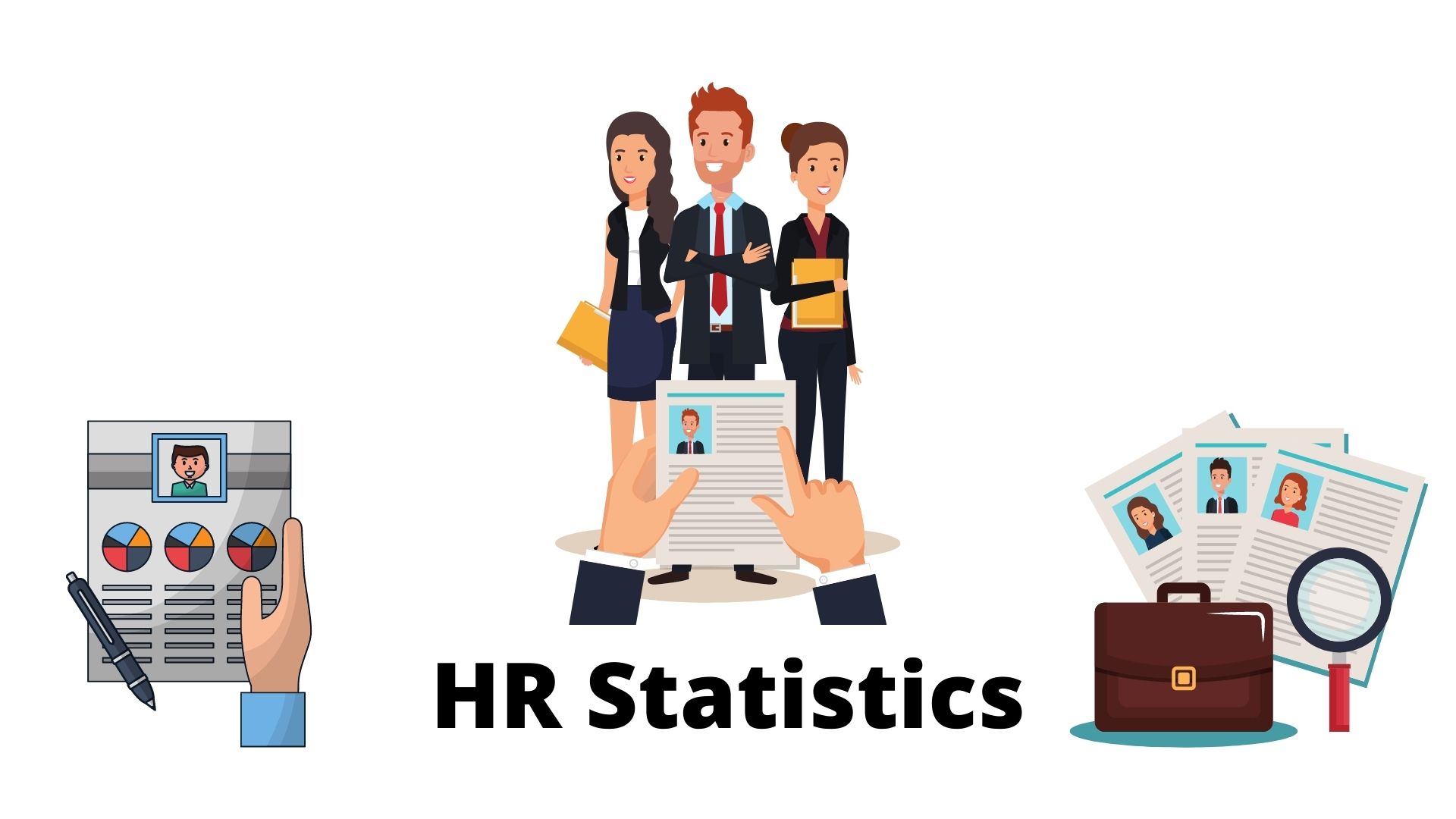30+ Shocking Workplace Stress Statistics – By Age and Gender, Top Causes and Coping
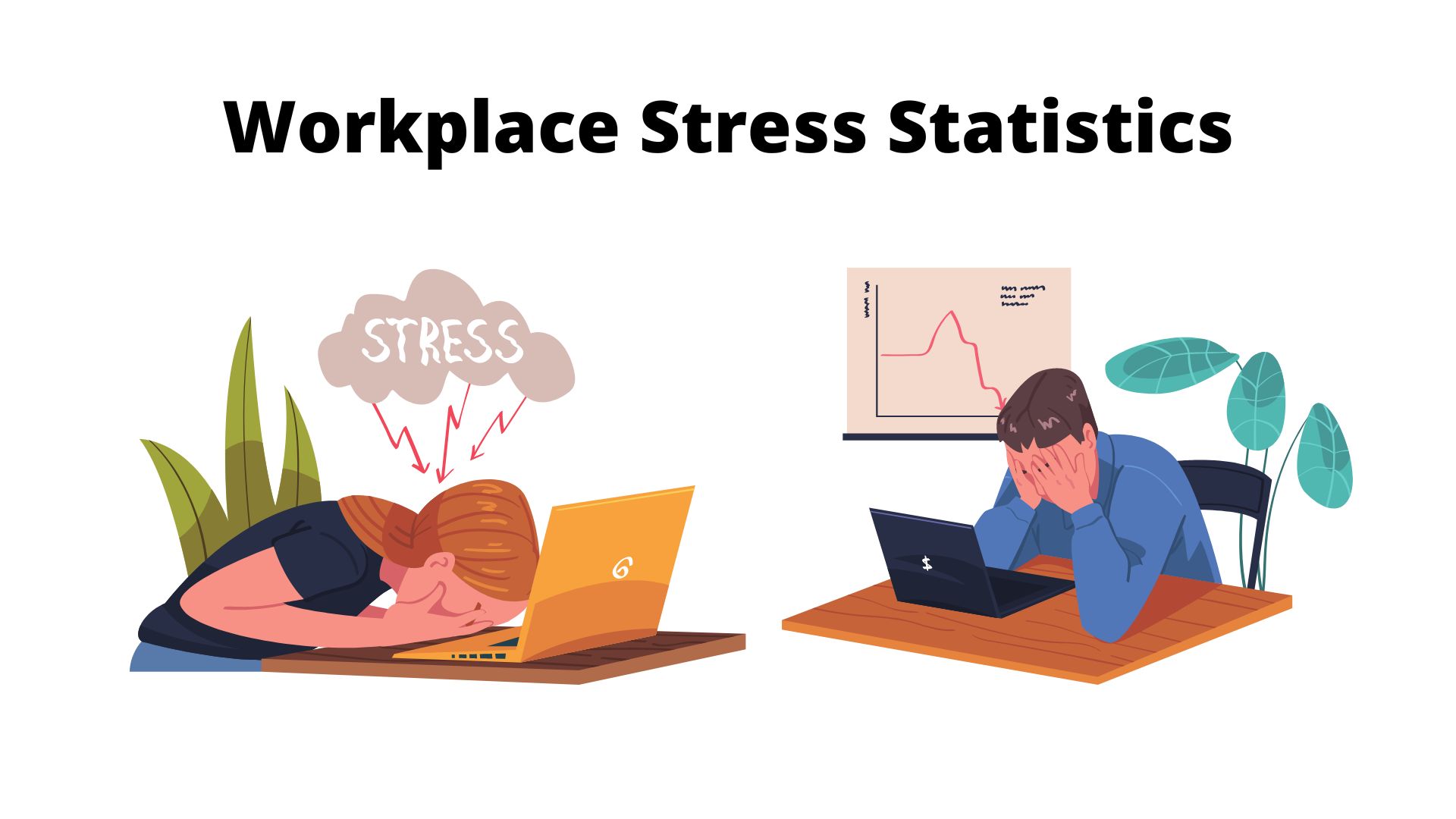
Page Contents
- Interesting Workplace Stress Statistics (Editor's Choice)
- General Workplace Stress Statistics
- Top Causes Statistics
- Productivity Statistics
- Workplace Stress Statistics by Region and Countries
- Coping Statistics
- Statistics By Industry And Job
- Avg. Days Per Week Of Stress By Industry
- Statistics By Employee Age And Gender
- Workplace Stress Statistics Over Time
- Stress Effect On Health Statistics
- Conclusion
Workplace Stress Statistics: Stress can significantly negatively impact a person's mental and physical health. One of the biggest obstacles you can face at work is workplace stress. There are many different types of work-related stress, spanning a wide range of sectors and professions. Stress at work impacts employees' relationships, productivity, happiness, and tenure at a company. For businesses, workplace stress can cause employee unhappiness, turnover, low productivity, and more. This article will discuss workplace stress statistics, facts, and trends.
Interesting Workplace Stress Statistics (Editor's Choice)
- As of 2023, in the United States, the annual price tag of Workplace stress has resulted in $300 billion.
- In the same year, due to workplace stress 56% of the U.S. government and corporate workers felt somewhat burned out and 27% felt high degree burnout.
- Huge burnout due to heavy workplace stress impacted negatively resulted in jobs being left out by Millennials (43%), and Gen Z (44%).
- In 2023, around 52% of men and 63% of women felt less stressed due to promoting remote work facilities which was agreed by 75% of employees along with enhancing employee retention.
- 6 full working days is more stressful as compared to 5 days agreed by 30% of men and 21% of women in 2023.
- On the other side, Australia and New Zealand experienced (47%); North Africa and the Middle East (45%)
- The workload is the number one cause of stress for 39% of employees.
- 80% of employees claim that a change in leadership impacts their stress levels.
- 1 million workers in the United States miss their work every day because of stress.
- The United States suffers from depression-induced absenteeism which costs US employers around $51 billion annually and 26 billion in treatment expenditures.
- 83% of United States employees experience work-related stress, with nearly 25% of workers claiming that their job is the most significant stressor in their lives.
- Stress causes more than 50% of people to lose interest in their jobs, which decreases productivity.
- Women and men handle workplace stress by smoking (27%), more often (25%), and drinking more caffeine (31%).
- In 2023, around 62% of working females in the United States and Canada reported feeling stressed daily, compared to 52% of males.
- Approximately 50% of North American, Latin American, Caribbean, and Canadian employees said they experience stress daily.
- According to 76% of US employees, workplace stress affects personal relationships.
- Stress at work causes 120,000 deaths and results in $190 billion in medical expenses yearly.
- Participants of middle age had a nearly 27% increase in the belief that stress would affect their financial situation in the 2010s than in the 1990s.
- Businesses typically spend about 75% of employee's annual salary to replace staff or cover lost productivity.
General Workplace Stress Statistics
Most people feel stress at some point during the day, regardless of their job, profession, or industry.
Alarming stats about workplace stress are only expected to rise, which points to organizations' need to change their expectations, work-life balance, mental health resources, and other areas. We have discovered the following facts through our research:
#1. Only 6% of employees say they never feel stressed at work. Approximately 23% indicated they were stressed, while 6% of workers stated that their stress levels were unreasonably high.
#2. 55% of employees in the United States experience stress throughout the day.
#3. As of 2023, across the world, almost 17 million working days were missed due to workplace stress such as anxiety and depression.
#4. 48% of workers said they feel more callous towards individuals since they started their job.
#5. Approximately 57% of American and Canadian employees said they experience stress daily, compared to 43% of persons who feel the same way worldwide. The rate of everyday job-related stress among Canadians and Americans has increased by 8% year-over-year.
#6. Low wage is the primary cause of workplace stress claimed by 56% of American workers.
#7. 30% of survey participants reported that stress related to their careers or jobs was a regular cause. This percentage rises to 44% among Gen Z and Millenials, demonstrating that stress is increasing among younger generations and presents a more significant worldwide issue than it did 30 or 20 years ago.
#8. 79% of employees said workplace stress had experienced difficulties at work, and more than 10% of workers reported that workplace stress caused a significant impact on their lives.
#9. The average employee in the United States rates their stress level at 4.9 on a scale of 1-10.
#10. 42% of workers state that yelling and other forms of verbal abuse are common, and 29% report that they have yelled at their coworkers due to workplace stress.
Top Causes Statistics
Even though not all occupations are created equal, the pressures that come with a job's responsibilities can be relatively common. Many of these reasons come from communication problems with coworkers, strained relationships with leadership or management, and Work-life balance issues.
According to the Workplace Health Reports 2023, around 76% of employees across the world have experienced moderate-to-high stress levels which has increased from last year.
#11. More than 65% of workers report that it is challenging to focus due to their work environment, compared to 46% of employees in 2018.
It is well known that a workplace's environment can affect employees' morale, productivity, and mental health.
According to the ADAA's workplace productivity statistics, employees identify workplace productivity (56%) and believe that relationships with colleagues and peers (47%) are the two main areas where anxiety and stress have the most significant adverse effects on workers. Around 58% of workers have quit their jobs or are considering doing so due to toxic office politics.
#12. The workload is the number one cause of stress for 73%% of employees.
Other primary sources of stress in the workplace are job security (16%), juggling personal and work lives (19%), and interpersonal issues (31%).
Other common stress aspects include a lack of support (29%), lack of control (31%), job security (16%), insufficient training (14%), commuting (12%), working from home (8%), and bullying (3%).
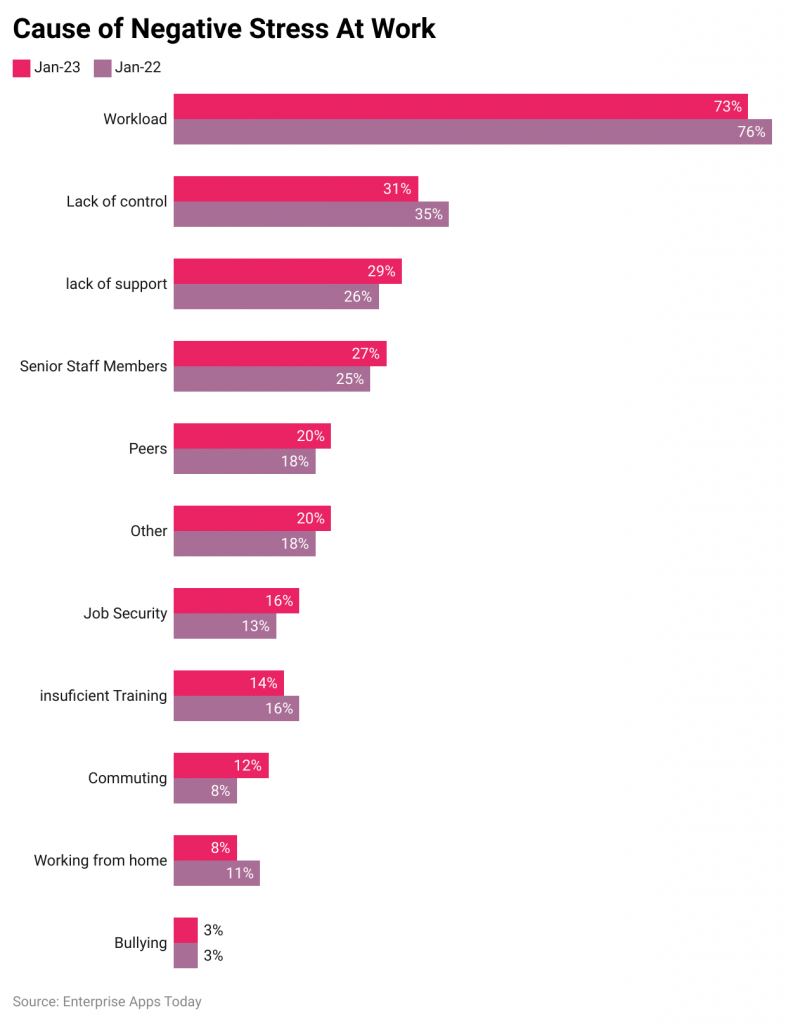
(Source: championhealth.co.uk)
#13. 80% of employees claim that a change in leadership impacts their stress levels.
Management and leaders teams can determine the responsibilities & workload, strategic direction, as well as teams' overall morale.
According to expert research, around 60% of employees have quit their jobs or would leave them over a poor boss.
Another study found that nearly 31% of surveyed United States employees stated that being unclear about the expectations from the managers is the most stressful factor in work.
#14. 80% of US employees reported feeling stressed out due to poor company communication.
Without communication, it can be challenging for management and staff members to understand where boundaries lie.
– 1 in 4 workers strongly disagrees that their manager offers emotional support to help them cope with stress.
– 1 in 3 employees say their managers believe work should be the top priority and come before family life, and around a third of workers say their company believes the perfect worker would be available around the clock.
Productivity Statistics
Even though stress occasionally serves as a motivator, negative stress can have detrimental effects on the worker and the business. Stress can harm productivity, employee health, and worker retention.
These statistics show how seriously workplace stress can affect both organizations and individuals:
#15. 63% of United States employees are ready to leave their jobs because of stress, while 16% of employees have already left a previous job because of stress.
#16. US companies lose up to $300 billion annually as a result of stress in the workplace.
#17. Employees who take sick days because of mental health concerns are 7 times more likely to miss more work than employees who have physical health issues.
#18. Approximately 1 million employees miss work every day due to stress.
#19. More than 56% of workers said they spend time searching for new jobs, compared with 40% of employees in 2023.
#20. Just 40% of workers who experience stress have discussed it with their employer.
#21. Only 40% of employees who experience stress have discussed it with their employer. Additionally, 34% of employees don't feel comfortable reporting stress to their company because it could be interpreted as an unwillingness or lack of interest to do the task.
#22. Over a third (33%) of stressed office employees believe they will be burnt out within the next twelve months.
#23. Stress at work causes 120,000 deaths and results in $190 billion in medical expenses yearly.
Workplace Stress Statistics by Region and Countries
- In the United States of America, the level of stress reported by full-time office worker are followed by moderate stress (39%), low stress (27%), high stress (23%), unsustainable stress (6%), and no stress (5%).
- East Asia belongs to the top with 55% of workers facing daily basis stress.
- Approximately 50%of North American, Latin American, Caribbean, and Canadian employees said they experience stress daily.
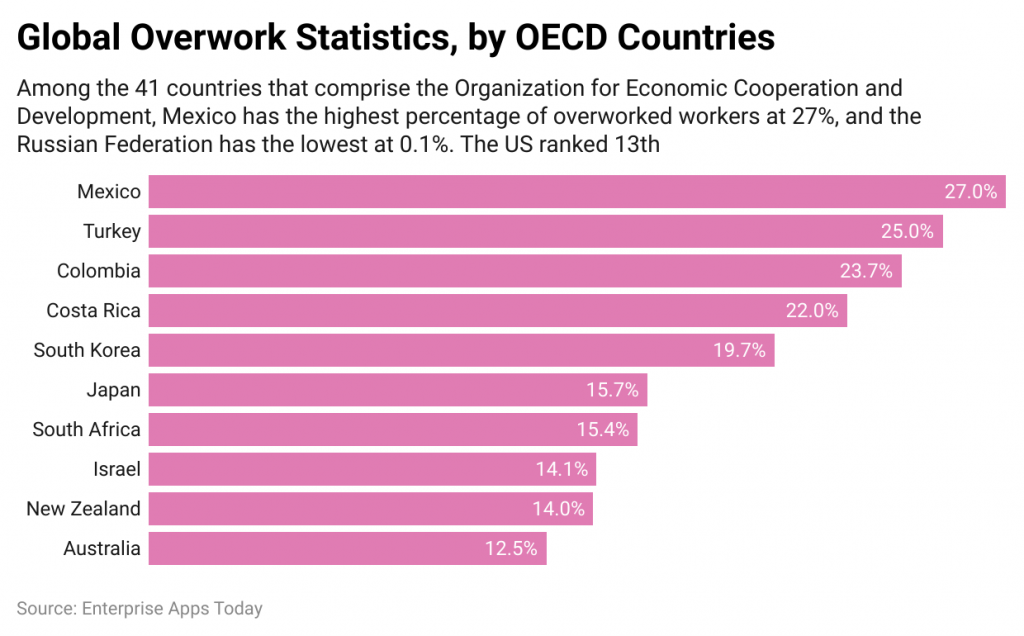
(Source: cfah.org)
Coping Statistics
Many people who encounter stress at the workplace must learn how to handle it both professionally and personally. Most of the time, office stress crosses the border into personal life and starts to affect workers' relationships and habits as well as mental health.
We have gathered the following statistics to show how much workplace stress affects workers outside of work.
#24. Women and men handle workplace stress by smoking (27%), more often (25%), and drinking more caffeine (31%).
However, women and men typically handle stress in slightly different ways from the opposite gender.
For instance, women typically eat more (46% of females compared to 27% of males) and talk with family and friends (44% compared to 21%), although males are more likely to have more frequent sex (19% compared to 10%), while 12% of male use illicit drugs to cope (compared to just 2% of female).
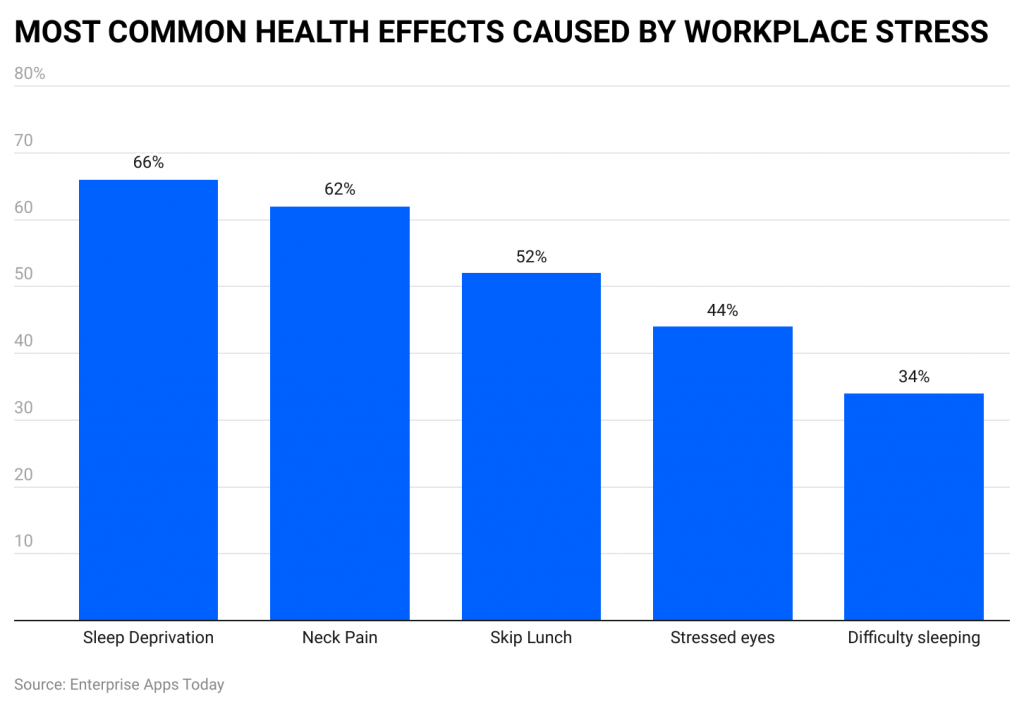
(Source: zippia.com)
#25. 83% of survey participants agreed (slightly too strongly agree) that workplace stress impacts their mental health.
Approximately 83% of survey participants felt emotionally deprived of their work, and more than 40% of respondents agreed strongly with this statement.
#26. As of 2023, around 76% of US employees said workplace stress harmed their personal relationships.
More than 20% of employees spend over 5 hours of their weekly workplace time thinking about their stressors or worries.
Statistics By Industry And Job
Workplace stress indeed varies by job and sector. For instance, those who choose public safety or healthcare careers frequently experience higher stress levels than those who work in other industries.
We have listed some of the most and least stressful careers and jobs. These are vital considerations to make when planning your goals and career path.
Most Stressful Jobs and Their Median Wages, 2023:
- Public relations executive: $111,280
- Event coordinator: $48,290
- News Reporter: $39,370
- Airline pilot: $111,930
- Enlisted military personnel of 3 to 4 years: $26,802
- Broadcaster: $62,960
- Firefighter: $49,080
- Police officer: $62,960
Lease Stressful Jobs and Their Median Wages:
- Operations research analyst: $81,390
- Diagnostic medical sonographer: $71,410
- Jeweler: $37,960
- Compliance officer: $67 870
- Medical records technician: $67,870
- Audiologist: $75,920
- University professor: $76,000
- Hair stylist: $25,850
The following sectors have the highest levels of stress among employees:
Avg. Days Per Week Of Stress By Industry
| Industry | Average Days Of Stress |
|---|---|
| Broadcasting, Publishing, and Journalism | 3.24 |
| Technology | 3.25 |
| Hotel, Hospitality, and Food Services | 3.31 |
| Military and Public Safety | 3.35 |
| Telecommunications | 3.38 |
| Wholesale and Retail | 3.39 |
| Entertainment, Arts, and Recreation | 3.41 |
| Marketing & Advertising | 3.84 |
Statistics By Employee Age And Gender
Like many career paths and industries, stress levels at the workplace can majorly vary based on age, gender, race, and sexual preference. Even though there has been a lot of progress in many companies and industries, there's a lot more work to be done. These statistics show how stress at work can differ from one individual to another.
#27. Around 62% of working females in the United States and Canada reported feeling stressed daily, compared to 52% of males.
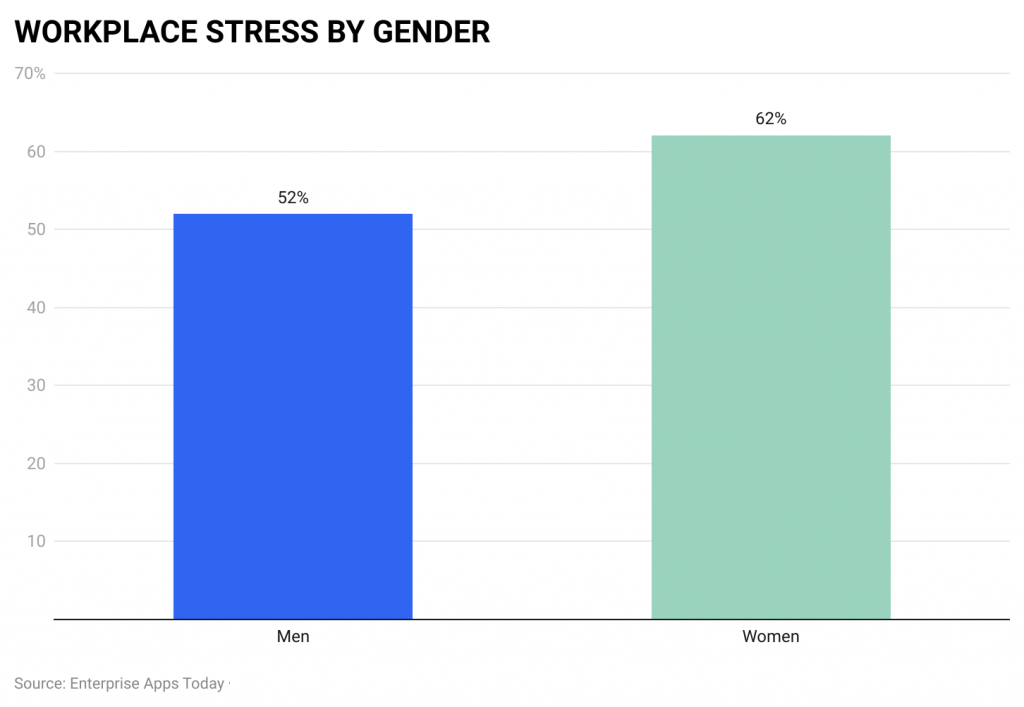
(Source: zippia.com)
#28. According to the APA Stress in the United States 2016 poll, women reported having a stress level of 5.1 on a scale of 1 to 10, while males reported having a stress level of 4.4.
#29. The most stressed-out age group among Americans is 30 to 49, with nearly 65% of workers reporting high levels of workplace stress. Americans between the ages of 15 to 29 are right behind them, with 64%, while 44% of individuals older than 50 or more reported feeling stressed out.
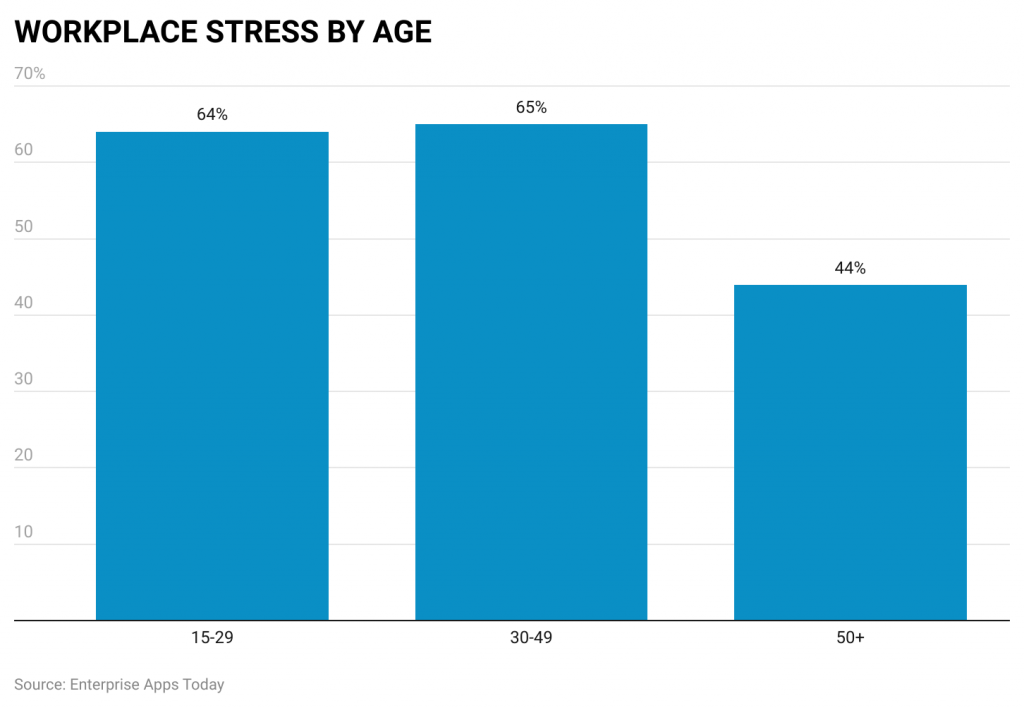
(Source: zippia.com)
#30. Around 50% of all LGBTQ+ workers remain closeted at the workplace, and roughly 43% of gay people and 90% of transgender people report mistreatment or harassment.
Workplace Stress Statistics Over Time
The stress level in the workplace continues to rise as time goes on. This could be because of high competition, increasing expectations, and a lack of staffing or resources. Professionals in today's generation are on the verge of burnout. Our analysis shows:
#31. Participants in the middle age surveys indicated around 17% rise in their belief that stress will impact their future plans. Additionally, they had a roughly 27% increase in the belief that stress would affect their financial situation in 2010 compared to the 1990s.
#32. 75% of employees believe they are experiencing a higher level of stress at the workplace than earlier generations.
Stress Effect On Health Statistics
While workplace stress can significantly impact an organization's bottom line, workers should focus on its effects on their overall health. Even though stress can occasionally seem manageable, it can have a negative impact on one's health, especially if they have been dealing with it for some time.
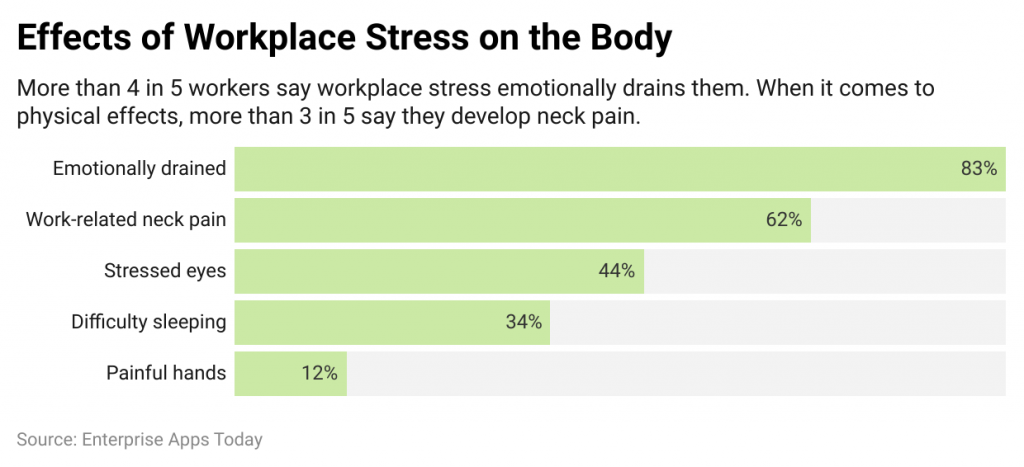
(Source: cfah.org)
As of 2023, the percentage of workers statistics by physical effects of Workplace stress are followed by emotionally drained (83%), work-related neck pain (62%), stressed eyes (44%), difficulty sleeping (34%), and painful hands (12%).
The following stats show how workplace stress impacts health:
#33. The consequences of stress-related disease cost organizations an anticipated 200-300 billion annually in lost productivity.
Depression can lead to $51 billion in costs because of absenteeism and roughly $26 billion in treatment expenses.
Businesses typically spend approximately 75% of an employee's yearly salary to replace staff or cover lost productivity. The yearly cost of lost productivity because of absenteeism tied to poor health was over $84 billion in 2013.
#34. Nearly 80% of employees say they experience stress at the workplace, and almost half of the workers say they need assistance learning how to manage their stress.
It has been demonstrated that companies that offer effective stress management reduce the costs of sick absences by up to 20%. Every day, 1 million employees miss work due to stress.
#35. Stress caused a lack of sleep in 72% of US employees in 2023.
Over 50% of respondents stated that they frequently work 12-hour days, and the same number of workers said they often skip lunch because of demands and stress.
Nearly 62% of employees reported having neck pain at the end of the day, 44% of people reported having stressed-out eyes, and around 34% of workers reported having trouble falling asleep because of stress. This type of constant stress can wreak havoc on a person's mental and physical health.
#36. Excessive stress at the workplace can cause a startling 120,000 deaths and result in approximately $190 billion in healthcare expenses every year.
Depression can lead to around $51 billion because of absenteeism and roughly $26 billion in medical expenses. Healthcare expenses for stressed-out employees are twice as high as those for regular workers.
Conclusion
For many people who experience stress in the workplace can be difficult. The good news is that you can start changing your habits as soon as you become aware of them. Every week, take some time to consider your accomplishments, record the things that caused you stress at work, and plan a better week the following week.
It's crucial to remember that job can and frequently will be stressful for many individuals. The statistics mentioned above indicate that stress can seriously harm our health and put us in danger of burnout. The only time stress becomes a problem is when it affects other areas of our lives.
Determining the precise source of stress can help reduce its impact. If you can identify the things in the workplace that make you feel fear, lack of control, or uncertain, you will be better able to deal with them directly or find solutions.
If you are experiencing some kind of stress at your workplace, you are likely not the only person. So make sure to get in touch with your human resources, leadership team, manager, or even a friendly coworker when you feel a higher stress level.
Sources
FAQ.
No, stress is not good for workers. Employee performance is impacted by stress in three ways: by raising the likelihood of mistakes, lowering overall productivity, and increasing the risk of burnout. Long-term effects include disengaged workers, higher absenteeism rates, and costly voluntary turnover.
Every profession involves at least modest pressure, and it is unreasonable to think that workers will never experience work-related stress. It's not true that a stressed-out and overworked team will yield better results.
There are several organizational strategies to manage stress at work. For starters, good hiring practices are essential to ensure that new hires can be well-suited for their roles and are trained in their responsibilities.
Some of the biggest and most frequent causes of workplace stress can be giving employees clear instructions, objective performance indicators, and regular feedback. Employees complaining of a lack of consistent and clear communication are common reasons for stress. Make this your top priority.
Encourage breaks by fostering a company culture that accepts (a reasonable amount of) downtime. Instead, create a culture where workers don't feel awful or like they will have a tonne of work to do after taking a vacation with their pad time off days.
Provide organization-sponsored counseling programs if at all possible. Although it may be costly to establish your mental health department in your workplace, it will pay off in the long term to keep your employees mentally and emotionally healthy.
These perks can also help increase retention rates, which will save you money on re-training and re-hiring replacements.
According to 25% of Americans, stress at work is the most significant stressor in their lives. Around, 83% of employees in the US report experiencing work-related stress, therefore it is reasonable to assume that the workplace accounts for more than half of all stress.
The typical causes of workplace stress include difficulty maintaining work-life balance, poor relationships with coworkers, leadership changes, and, most importantly, high workloads.
In today's world, it may feel impossible to close, even after a whole day of work. But just because you work a high-profile job doesn't mean you should bring it home. Be sure to set proper boundaries with your boss, your work, and your coworkers. Set realistic expectations and make it clear to coworkers where boundary lines lie.
For instance, you should block your calendar at 6 p.m., so you do not schedule meetings after 6 o'clock. Set aside time to take a lunch break, and avoid checking your email on the weekend. Such type of changes in your life may assist you in reprioritizing your personal life from work when it's suitable.
There are a few different factors to consider to help manage or reduce your stress, depending on what is causing it. For instance, it is vital to take breaks, learn to prioritize, and set boundaries if you are stressed out from being overworked.
You can overcome uncertainty by communicating well, getting clear feedback, and finding the courage to speak to your coworkers or boss about your stress levels.
If you suspect that you may be dealing with extreme workplace stress, there are several different signs, such as you can feel insecure and might lose your confidence. Also, you might get upset, withdraw, or angry.
Additional signs and symptoms may include apathy, insomnia, anxiety, losing interest in your work, difficulties concentrating, fatigue, muscle tension or headaches, digestion problems, social withdrawal, or using alcohol or drugs to cope.

Barry is a lover of everything technology. Figuring out how the software works and creating content to shed more light on the value it offers users is his favorite pastime. When not evaluating apps or programs, he's busy trying out new healthy recipes, doing yoga, meditating, or taking nature walks with his little one.


